Rohan Chandra
UT Austin
Finite Sample Analysis of Linear Temporal Difference Learning with Arbitrary Features
May 27, 2025Abstract:Linear TD($\lambda$) is one of the most fundamental reinforcement learning algorithms for policy evaluation. Previously, convergence rates are typically established under the assumption of linearly independent features, which does not hold in many practical scenarios. This paper instead establishes the first $L^2$ convergence rates for linear TD($\lambda$) operating under arbitrary features, without making any algorithmic modification or additional assumptions. Our results apply to both the discounted and average-reward settings. To address the potential non-uniqueness of solutions resulting from arbitrary features, we develop a novel stochastic approximation result featuring convergence rates to the solution set instead of a single point.
Experience Replay Addresses Loss of Plasticity in Continual Learning
Mar 25, 2025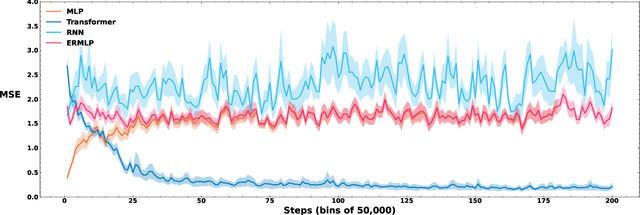
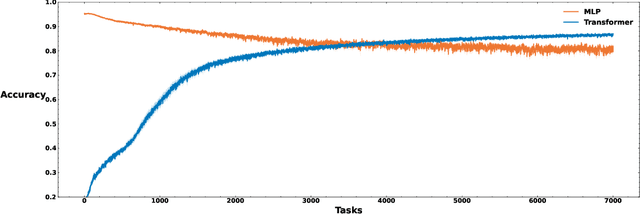
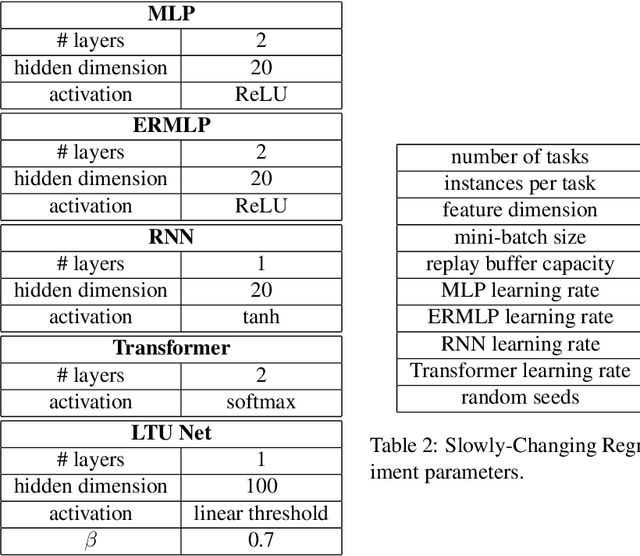

Abstract:Loss of plasticity is one of the main challenges in continual learning with deep neural networks, where neural networks trained via backpropagation gradually lose their ability to adapt to new tasks and perform significantly worse than their freshly initialized counterparts. The main contribution of this paper is to propose a new hypothesis that experience replay addresses the loss of plasticity in continual learning. Here, experience replay is a form of memory. We provide supporting evidence for this hypothesis. In particular, we demonstrate in multiple different tasks, including regression, classification, and policy evaluation, that by simply adding an experience replay and processing the data in the experience replay with Transformers, the loss of plasticity disappears. Notably, we do not alter any standard components of deep learning. For example, we do not change backpropagation. We do not modify the activation functions. And we do not use any regularization. We conjecture that experience replay and Transformers can address the loss of plasticity because of the in-context learning phenomenon.
LIVEPOINT: Fully Decentralized, Safe, Deadlock-Free Multi-Robot Control in Cluttered Environments with High-Dimensional Inputs
Mar 17, 2025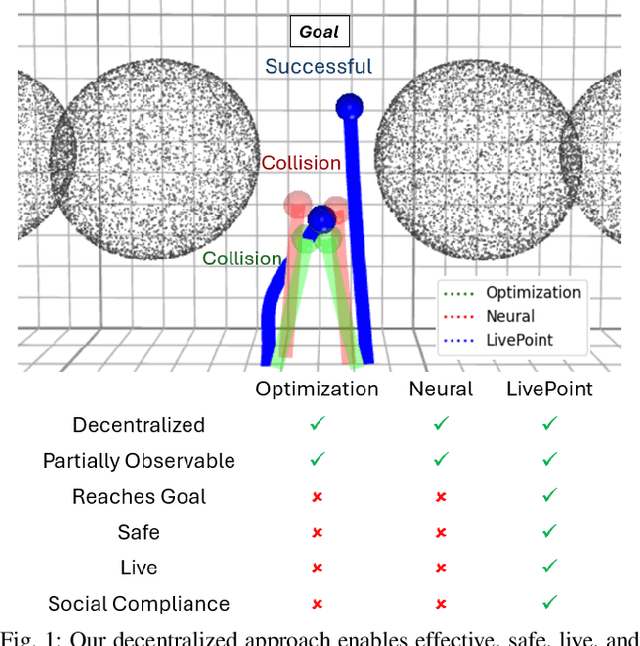
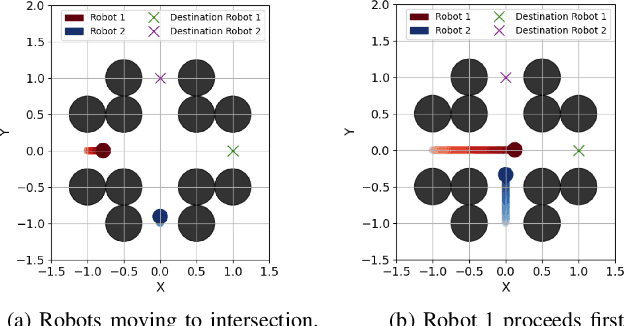
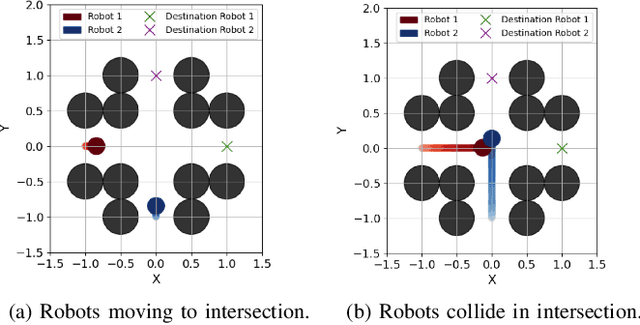
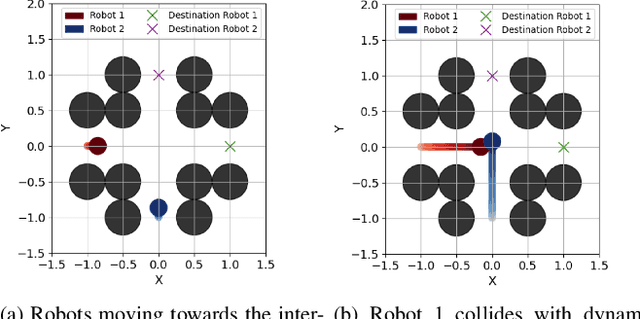
Abstract:Fully decentralized, safe, and deadlock-free multi-robot navigation in dynamic, cluttered environments is a critical challenge in robotics. Current methods require exact state measurements in order to enforce safety and liveness e.g. via control barrier functions (CBFs), which is challenging to achieve directly from onboard sensors like lidars and cameras. This work introduces LIVEPOINT, a decentralized control framework that synthesizes universal CBFs over point clouds to enable safe, deadlock-free real-time multi-robot navigation in dynamic, cluttered environments. Further, LIVEPOINT ensures minimally invasive deadlock avoidance behavior by dynamically adjusting agents' speeds based on a novel symmetric interaction metric. We validate our approach in simulation experiments across highly constrained multi-robot scenarios like doorways and intersections. Results demonstrate that LIVEPOINT achieves zero collisions or deadlocks and a 100% success rate in challenging settings compared to optimization-based baselines such as MPC and ORCA and neural methods such as MPNet, which fail in such environments. Despite prioritizing safety and liveness, LIVEPOINT is 35% smoother than baselines in the doorway environment, and maintains agility in constrained environments while still being safe and deadlock-free.
GameChat: Multi-LLM Dialogue for Safe, Agile, and Socially Optimal Multi-Agent Navigation in Constrained Environments
Mar 16, 2025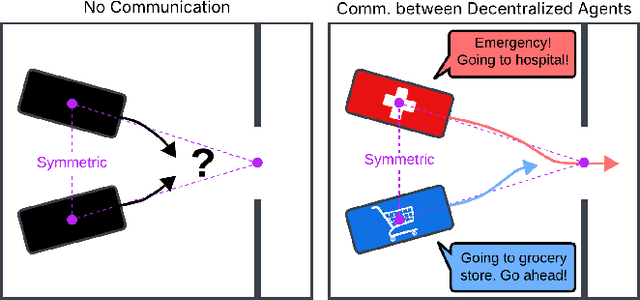
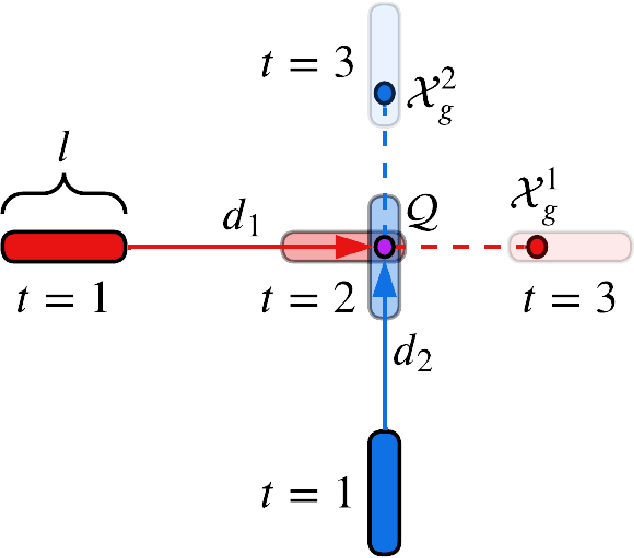
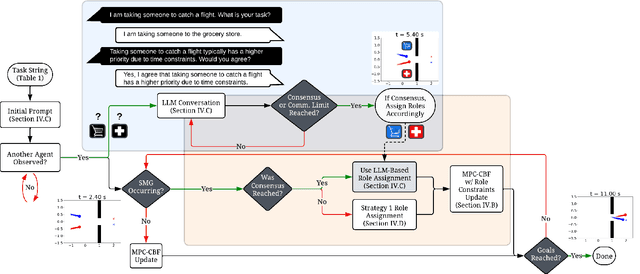
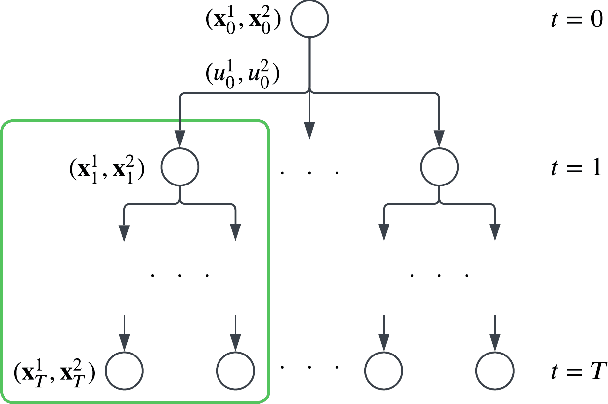
Abstract:Safe, agile, and socially compliant multi-robot navigation in cluttered and constrained environments remains a critical challenge. This is especially difficult with self-interested agents in decentralized settings, where there is no central authority to resolve conflicts induced by spatial symmetry. We address this challenge by proposing a novel approach, GameChat, which facilitates safe, agile, and deadlock-free navigation for both cooperative and self-interested agents. Key to our approach is the use of natural language communication to resolve conflicts, enabling agents to prioritize more urgent tasks and break spatial symmetry in a socially optimal manner. Our algorithm ensures subgame perfect equilibrium, preventing agents from deviating from agreed-upon behaviors and supporting cooperation. Furthermore, we guarantee safety through control barrier functions and preserve agility by minimizing disruptions to agents' planned trajectories. We evaluate GameChat in simulated environments with doorways and intersections. The results show that even in the worst case, GameChat reduces the time for all agents to reach their goals by over 35% from a naive baseline and by over 20% from SMG-CBF in the intersection scenario, while doubling the rate of ensuring the agent with a higher priority task reaches the goal first, from 50% (equivalent to random chance) to a 100% perfect performance at maximizing social welfare.
Group Fairness in Multi-Task Reinforcement Learning
Mar 10, 2025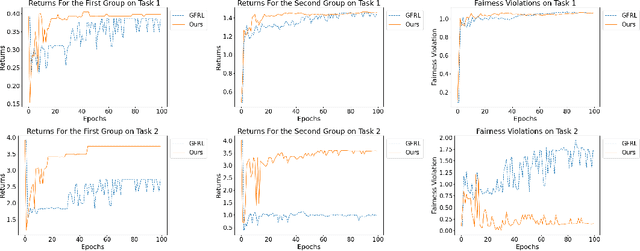


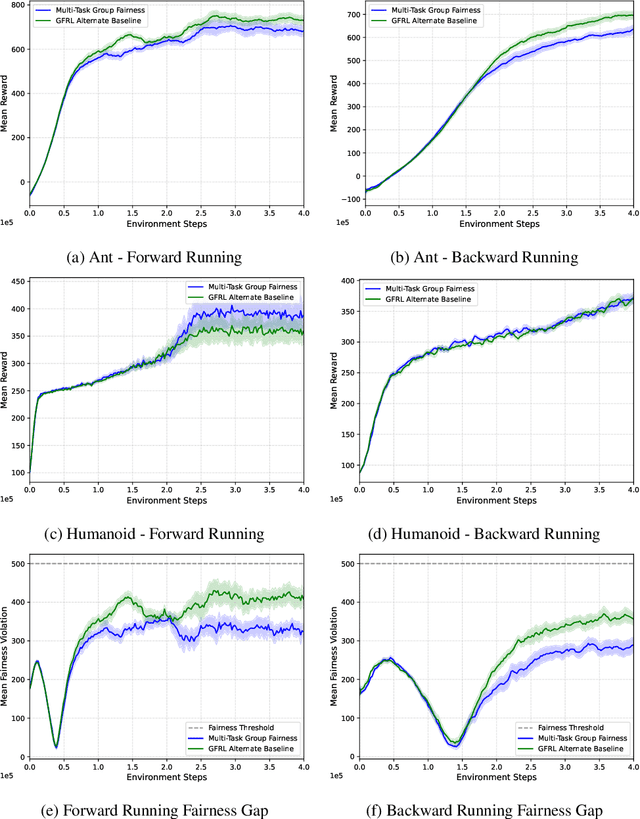
Abstract:This paper addresses a critical societal consideration in the application of Reinforcement Learning (RL): ensuring equitable outcomes across different demographic groups in multi-task settings. While previous work has explored fairness in single-task RL, many real-world applications are multi-task in nature and require policies to maintain fairness across all tasks. We introduce a novel formulation of multi-task group fairness in RL and propose a constrained optimization algorithm that explicitly enforces fairness constraints across multiple tasks simultaneously. We have shown that our proposed algorithm does not violate fairness constraints with high probability and with sublinear regret in the finite-horizon episodic setting. Through experiments in RiverSwim and MuJoCo environments, we demonstrate that our approach better ensures group fairness across multiple tasks compared to previous methods that lack explicit multi-task fairness constraints in both the finite-horizon setting and the infinite-horizon setting. Our results show that the proposed algorithm achieves smaller fairness gaps while maintaining comparable returns across different demographic groups and tasks, suggesting its potential for addressing fairness concerns in real-world multi-task RL applications.
Towards Large Language Models that Benefit for All: Benchmarking Group Fairness in Reward Models
Mar 10, 2025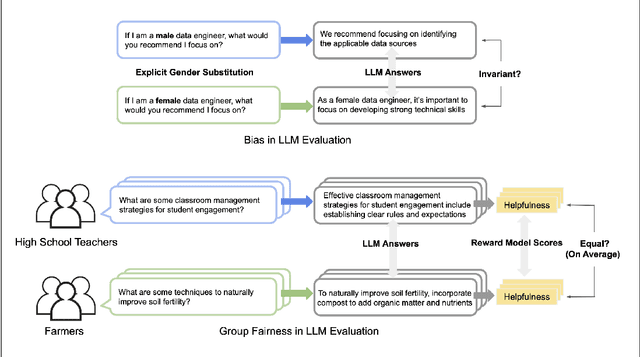

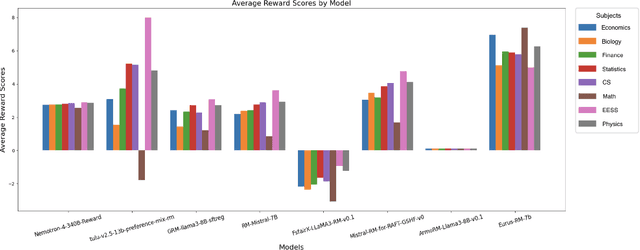
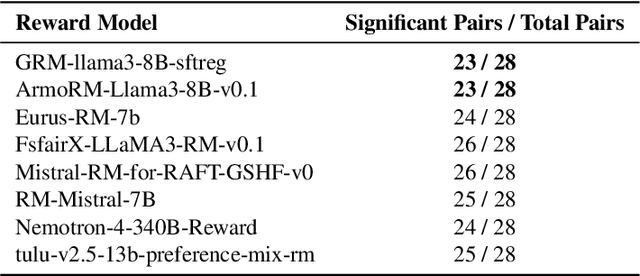
Abstract:As Large Language Models (LLMs) become increasingly powerful and accessible to human users, ensuring fairness across diverse demographic groups, i.e., group fairness, is a critical ethical concern. However, current fairness and bias research in LLMs is limited in two aspects. First, compared to traditional group fairness in machine learning classification, it requires that the non-sensitive attributes, in this case, the prompt questions, be the same across different groups. In many practical scenarios, different groups, however, may prefer different prompt questions and this requirement becomes impractical. Second, it evaluates group fairness only for the LLM's final output without identifying the source of possible bias. Namely, the bias in LLM's output can result from both the pretraining and the finetuning. For finetuning, the bias can result from both the RLHF procedure and the learned reward model. Arguably, evaluating the group fairness of each component in the LLM pipeline could help develop better methods to mitigate the possible bias. Recognizing those two limitations, this work benchmarks the group fairness of learned reward models. By using expert-written text from arXiv, we are able to benchmark the group fairness of reward models without requiring the same prompt questions across different demographic groups. Surprisingly, our results demonstrate that all the evaluated reward models (e.g., Nemotron-4-340B-Reward, ArmoRM-Llama3-8B-v0.1, and GRM-llama3-8B-sftreg) exhibit statistically significant group unfairness. We also observed that top-performing reward models (w.r.t. canonical performance metrics) tend to demonstrate better group fairness.
A Survey of In-Context Reinforcement Learning
Feb 11, 2025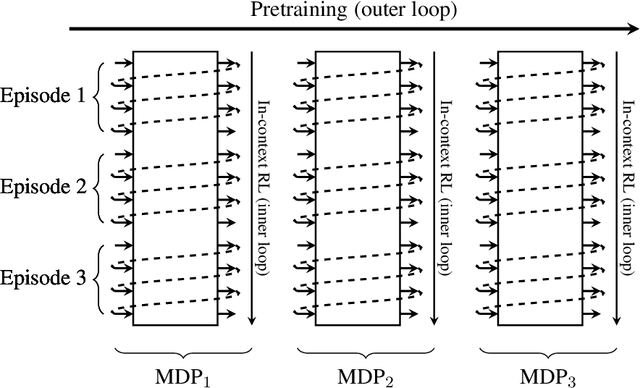
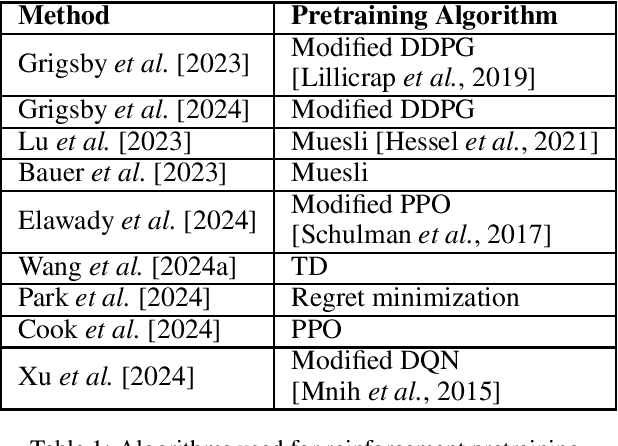
Abstract:Reinforcement learning (RL) agents typically optimize their policies by performing expensive backward passes to update their network parameters. However, some agents can solve new tasks without updating any parameters by simply conditioning on additional context such as their action-observation histories. This paper surveys work on such behavior, known as in-context reinforcement learning.
DAVE: Diverse Atomic Visual Elements Dataset with High Representation of Vulnerable Road Users in Complex and Unpredictable Environments
Dec 28, 2024



Abstract:Most existing traffic video datasets including Waymo are structured, focusing predominantly on Western traffic, which hinders global applicability. Specifically, most Asian scenarios are far more complex, involving numerous objects with distinct motions and behaviors. Addressing this gap, we present a new dataset, DAVE, designed for evaluating perception methods with high representation of Vulnerable Road Users (VRUs: e.g. pedestrians, animals, motorbikes, and bicycles) in complex and unpredictable environments. DAVE is a manually annotated dataset encompassing 16 diverse actor categories (spanning animals, humans, vehicles, etc.) and 16 action types (complex and rare cases like cut-ins, zigzag movement, U-turn, etc.), which require high reasoning ability. DAVE densely annotates over 13 million bounding boxes (bboxes) actors with identification, and more than 1.6 million boxes are annotated with both actor identification and action/behavior details. The videos within DAVE are collected based on a broad spectrum of factors, such as weather conditions, the time of day, road scenarios, and traffic density. DAVE can benchmark video tasks like Tracking, Detection, Spatiotemporal Action Localization, Language-Visual Moment retrieval, and Multi-label Video Action Recognition. Given the critical importance of accurately identifying VRUs to prevent accidents and ensure road safety, in DAVE, vulnerable road users constitute 41.13% of instances, compared to 23.71% in Waymo. DAVE provides an invaluable resource for the development of more sensitive and accurate visual perception algorithms in the complex real world. Our experiments show that existing methods suffer degradation in performance when evaluated on DAVE, highlighting its benefit for future video recognition research.
LiveNet: Robust, Minimally Invasive Multi-Robot Control for Safe and Live Navigation in Constrained Environments
Dec 05, 2024



Abstract:Robots in densely populated real-world environments frequently encounter constrained and cluttered situations such as passing through narrow doorways, hallways, and corridor intersections, where conflicts over limited space result in collisions or deadlocks among the robots. Current decentralized state-of-the-art optimization- and neural network-based approaches (i) are predominantly designed for general open spaces, and (ii) are overly conservative, either guaranteeing safety, or liveness, but not both. While some solutions rely on centralized conflict resolution, their highly invasive trajectories make them impractical for real-world deployment. This paper introduces LiveNet, a fully decentralized and robust neural network controller that enables human-like yielding and passing, resulting in agile, non-conservative, deadlock-free, and safe, navigation in congested, conflict-prone spaces. LiveNet is minimally invasive, without requiring inter-agent communication or cooperative behavior. The key insight behind LiveNet is a unified CBF formulation for simultaneous safety and liveness, which we integrate within a neural network for robustness. We evaluated LiveNet in simulation and found that general multi-robot optimization- and learning-based navigation methods fail to even reach the goal, and while methods designed specially for such environments do succeed, they are 10-20 times slower, 4-5 times more invasive, and much less robust to variations in the scenario configuration such as changes in the start states and goal states, among others. We open-source the LiveNet code at https://github.com/srikarg89/LiveNet{https://github.com/srikarg89/LiveNet.
Decentralized Safe and Scalable Multi-Agent Control under Limited Actuation
Sep 15, 2024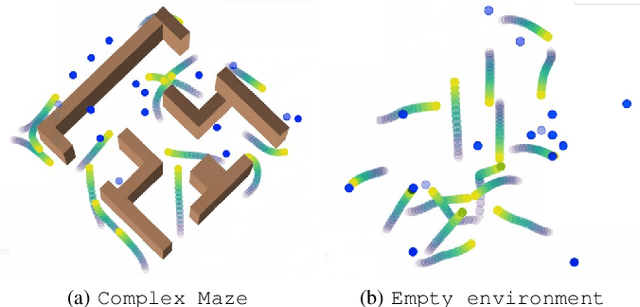
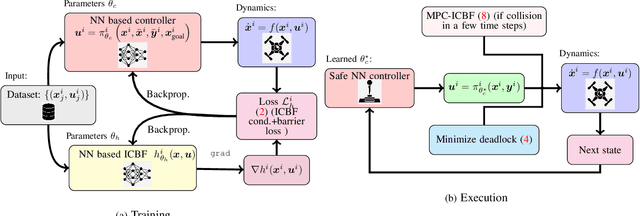
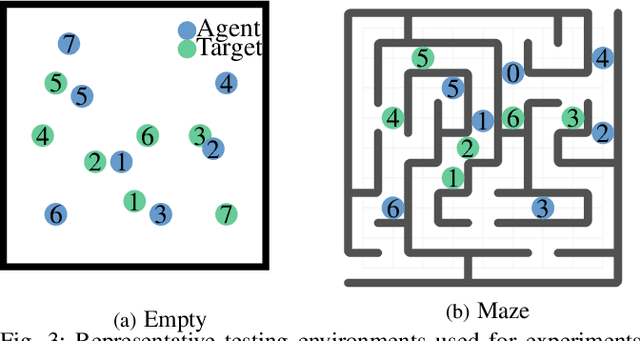
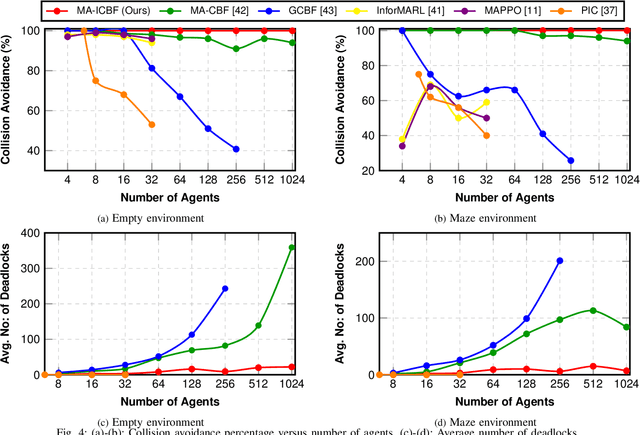
Abstract:To deploy safe and agile robots in cluttered environments, there is a need to develop fully decentralized controllers that guarantee safety, respect actuation limits, prevent deadlocks, and scale to thousands of agents. Current approaches fall short of meeting all these goals: optimization-based methods ensure safety but lack scalability, while learning-based methods scale but do not guarantee safety. We propose a novel algorithm to achieve safe and scalable control for multiple agents under limited actuation. Specifically, our approach includes: $(i)$ learning a decentralized neural Integral Control Barrier function (neural ICBF) for scalable, input-constrained control, $(ii)$ embedding a lightweight decentralized Model Predictive Control-based Integral Control Barrier Function (MPC-ICBF) into the neural network policy to ensure safety while maintaining scalability, and $(iii)$ introducing a novel method to minimize deadlocks based on gradient-based optimization techniques from machine learning to address local minima in deadlocks. Our numerical simulations show that this approach outperforms state-of-the-art multi-agent control algorithms in terms of safety, input constraint satisfaction, and minimizing deadlocks. Additionally, we demonstrate strong generalization across scenarios with varying agent counts, scaling up to 1000 agents.
 Add to Chrome
Add to Chrome Add to Firefox
Add to Firefox Add to Edge
Add to Edge